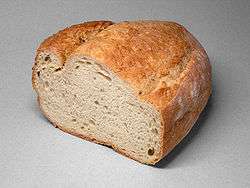Kneading


Kneading is a process in the making of bread or pasta dough, used to mix the ingredients and add strength to the final product. Its importance lies in the mixing of flour with water. When these two ingredients are combined and kneaded, the gliadin and glutenin proteins in the flour expand and form strands of gluten, which gives bread its texture.[1] (To aid gluten production, many recipes use bread flour, which is higher in protein than all-purpose flour.) The kneading process warms and stretches these gluten strands, eventually creating a springy and elastic dough. If bread dough is not kneaded enough, it will not be able to hold the tiny pockets of gas (CO2) created by the leavening agent (such as yeast or baking powder), and will collapse, leaving a heavy and dense loaf.
Kneading can be performed by hand (the traditional way), with a mixer equipped with a dough hook, or with a bread machine. In hand kneading, the dough is put on a floured surface, pressed and stretched with the heel of the hand, folded over, and rotated through 90° repeatedly. This process continues until the dough is elastic and smooth. The dough can then be allowed to rise or "prove".
Similar to kneading is knocking back or punching down, which is done to the dough after proving. The dough is punched once or twice, after which it is kneaded gently for a short time. The aim of this is to remove any large gas pockets which have formed in the dough, create an even texture in the bread and redistribute the nutrients for the yeast, thus allowing fermentation to continue. The dough can then be proved a second time. Another method of knocking back (also known as "folding") is to gently stretch and pat out the proved dough before folding the sides in towards the centre.
In bread baking, kneading can be substituted by allowing a relatively wet, low-yeast dough to rise for more than twelve hours; this method is referred to as no-knead bread.
See also
Footnotes
- ↑ "Scientific Insight into Breadmaking". Retrieved 2007-06-12.
External links
| Wikimedia Commons has media related to Kneading. |
